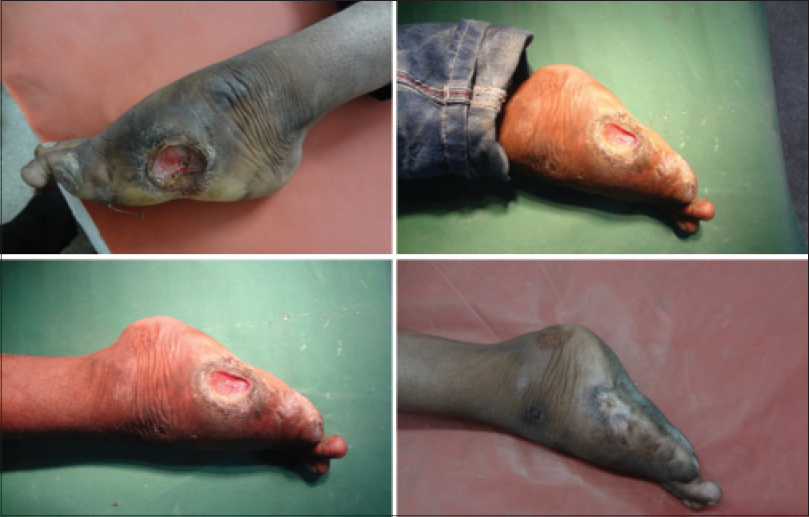Translate this page into:
Total contact casting in the treatment of nonhealing plantar ulcers in anesthetic foot
2 Department of Physical Medicine and Rehabilitation, King George's Medical University, Lucknow, Uttar Pradesh, India
Correspondence Address:
Siddharth Rai
236, Bhagwat Bagh, Attarsuiya, Allahabad - 211 003, Uttar Pradesh
India
| How to cite this article: Rai S, Gupta AK, Kumar D, Aggarwal AK, Sharma VP. Total contact casting in the treatment of nonhealing plantar ulcers in anesthetic foot. Indian J Dermatol Venereol Leprol 2016;82:422-423 |
Sir,
Chronic plantar ulcer, also known as trophic ulcer, is usually seen in a sensory-deficient foot. The clinical result of sensory, motor or autonomic loss of nerve function is frequently the same: ulceration.
In patients with peripheral sensory deficits, the protective pain perception is absent. Therefore, they do not relieve pressure on the affected extremity and the resultant repetitive trauma leads to breakdown of skin and ulceration.[1] Autonomic nerve loss also contributes to skin breakdown by making the skin dry and inelastic due to the loss of oil and sweat glands. Further, weakness of the short muscles of the foot leads to subluxation of the metatarsal head which causes a shearing stress leading to the development of a callosity. The risk of ulceration is even higher when a callus is present.
The treatment principle involves avoiding pressure on the ulcerated site, called “offloading.” Offloading can be achieved by complete bed rest, axillary crutches, walker, walking stick, half shoes, healing sandals, total contact casts with or without walking iron, etc.
We conducted a study in the Department of Physical Medicine and Rehabilitation, King George's Medical University, Lucknow, to determine the outcome of non-healing planter ulcers in the anesthetic foot, treated with offloading by total contact casting. We evaluated the rate and duration of healing and percentage of ulcers healed. Healing was assessed based on the improvement in Wagner's grading, taking into account the clinical profile of the patient. The study design was prospective, analytical. All the patients with anesthetic foot and trophic ulcers up to Grade 2 of Wagner's classification system, attending the outpatient department and who were willing to participate in the study were included.
A total of 30 patients with anesthetic foot and trophic ulcers who fulfilled the inclusion criteria were recruited. Patients with uncontrolled diabetes, lepra reactions, Charcot joint, contralateral foot ulcers, those on steroids and those who had undergone limb amputation were excluded. The mean age of the study group was 36.6 ± 18.8 years.
Detailed examination of all the patients was performed and neuropathic foot confirmed. Surgical debridement of the ulcers was done in all cases to remove the necrotic tissue, the surrounding callus and the infected material up to the viable tissues. For infected ulcers, appropriate antibiotics were given according to culture and sensitivity tests. Once the ulcers became clean, total contact cast with a walking iron was given for ambulation. The total contact cast was renewed every 2 weeks and the rate of healing was assessed.
We found that 24 (80%) of the 30 cases healed within 8 weeks; healing was defined as complete re-epithelialization of the wound [Figure - 1]. We did not find any complications in the healing process but two patients had relapse after healing of the ulcers. The average time taken for ulcer healing was 6.73 ± 1.92 weeks.
 |
| Figure 1: Progressive healing of a plantar ulcer in neuropathic foot |
Total contact cast technique was originally described in the 1930s by Dr. Joseph Khan in patients with Hansen's disease.[2] Dr. Paul Brand expanded the application of total contact casting to neuropathic ulceration in diabetes mellitus.[3]
Achieving pressure reduction is a critical component of therapy in the management of diabetic foot ulcers. Though offloading can be achieved by several orthotics, most of these are removable and strict compliance is not achieved thus reducing their effectiveness. Total contact cast has the advantage that it cannot be easily removed by the patient and limits activity which promotes rapid healing of ulcers. When correctly applied, it has proven not only to interrupt the chain of events in the pathogenic pathway that produces ulceration but it also changes the histology of the ulcer shifting it from a chronic inflammatory state to a more evolutive condition.[4]
The use of serial total contact cast in the treatment of neuropathic ulcers of the feet is a safe, effective, quick and inexpensive treatment modality. Our patients were mainly men of working age and hence the major advantages of cast therapy were the reduced time away from work and the reduction of the duration of inpatient treatment.
Limitations of the study were the small sample size and the lack of control subjects for comparison. We conclude that the study findings support the use of total contact cast as a good treatment modality to offload the limb in trophic ulcers with favourable healing rates.
Acknowledgement
We wish to thank our patients for their cooperation.
Financial support and sponsorship
Nil.
Conflicts of interest
There are no conflicts of interest.
| 1. |
Boulton AJ, Hardisty CA, Betts RP, Franks CI, Worth RC, Ward JD, et al. Dynamic foot pressure and other studies as diagnostic and management aids in diabetic neuropathy. Diabetes Care 1983;6:26-33.
[Google Scholar]
|
| 2. |
Khan JS. Treatment of leprous trophic ulcers. Lepr India 1939;11:19-21.
[Google Scholar]
|
| 3. |
Brand PW. Repetitive stress in the development of diabetic foot ulcers. In: Levin ME, O'Neil LW, editors. The Diabetic Foot. 4th ed. St. Louis, Mo: Mosby; 1988. p. 83-90.
[Google Scholar]
|
| 4. |
Piaggesi A, Macchiarini S, Rizzo L, Palumbo F, Tedeschi A, Nobili LA, et al. An off-the-shelf instant contact casting device for the management of diabetic foot ulcers: A randomized prospective trial versus traditional fiberglass cast. Diabetes Care 2007;30:586-90.
[Google Scholar]
|
Fulltext Views
3,651
PDF downloads
3,022





